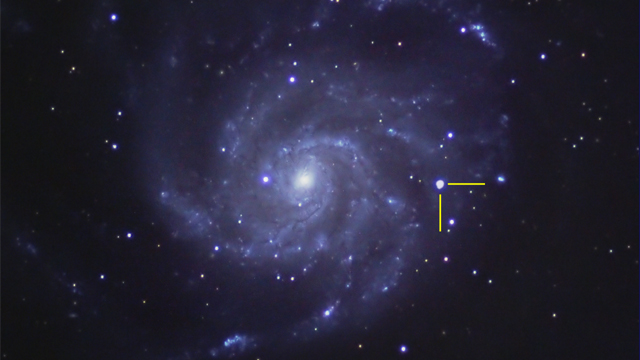That statement begs the question, are there different kinds of supernovae, and if so, what makes a Type 1A special?
Yes, there are different kinds, and I’d say that they’re all special. But 1As have one quality that makes them useful for things other than spectating a celestial fireworks show. A typical “core collapse” type supernova, of which Type 1A is not, occurs when a really massive star (significantly more massive than our Sun) burns through all of its nuclear fuel and collapses. The sudden collapse produces incredible pressure and temperature at the star’s core, enabling it to fuse the heavier atoms it produced from lighter ones over its lifetime. It goes off like a star-sized nuclear bomb, its outer layers blown away into space and its compressed core collapsing even further into a neutron star or a black hole, depending on its mass.
The amount of light released by this star death scenario depends on the mass of the original star and can vary widely, like a set of light bulbs with a range of wattages.
But a Type 1A supernova is produced by a different star death scenario. Picture a less massive star than one of those incredible hulk supernova producers, a star with about the mass of our own Sun, in fact, give or take. When this star runs out of nuclear fuel, it also collapses, but not violently. The star’s core collapses into an object called a White Dwarf, a compact and hot “cinder” roughly the size of the Earth. At the same time, the star’s outer shell sloughs off into space, expanding gracefully as a planetary nebula.
But there is a limit to the size that a White Dwarf can be. Below 1.38 times the mass of our Sun, a White Dwarf will remain a hot, though gradually cooling ball of material. If the situation arises where a White Dwarf below 1.38 solar masses acquires more mass—say, by pulling in material from a neighboring star, a stellar companion—and exceeds the magic limit, the White Dwarf suddenly collapses and, much as in the case of a “typical” supernova, becomes a stellar fusion bomb.
The trick is that this stellar fusion bomb is powered by the very precise physics of 1.38 solar masses suddenly collapsing from a White Dwarf, the result of which is that all Type 1A supernovae are equivalent in power and brightness. You’ve seen one 1A, you’ve seen them all….
Since all 1As have the same brightness, like a bunch of light bulbs of the same wattage, they’re excellent for measuring distances in the Universe. If we know the actual brightness of a Type 1A supernova, we can compare that to how bright a particular one appears to us, do a little math, and calculate with good precision how far away it, and by extension its home galaxy, is.
Type 1A supernovae are what made possible the recent, and unexpected, discovery that not only is the Universe expanding (as we knew), the rate of expansion is actually accelerating (something scientists did NOT expect).
And with SN 2011fe going off relatively close to us, in M-101, scientists have a chance to refine their understanding of the nature of the Type 1A supernova, increasing the power of the measuring stick….
That’s an eyeful. Come to Chabot and grab a peek this weekend (Sept 9 and 10), before it fades away….

